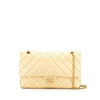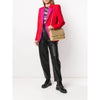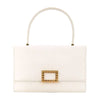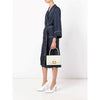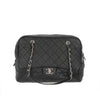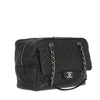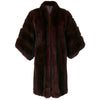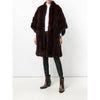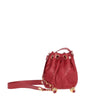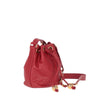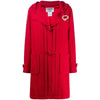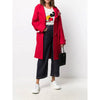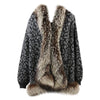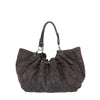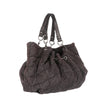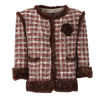In the world of vintage fashion, few names resonate as powerfully as A.N.G.E.L.O. Founded by Angelo Caroli in the late 1970s, this remarkable venture has become a cornerstone of the industry, amassing one of Europe’s largest archives of vintage clothing at “A.N.G.E.L.O. Vintage Palace”, located in Lugo, Italy. From its humble beginnings, fueled by a passion for unique, high-quality garments, A.N.G.E.L.O. has transformed the perception of second-hand fashion and paved the way for sustainability in the industry. In this exclusive interview, one of our co-founders, Alba Figueras de la Parte, sits down with Mr. Caroli to explore his inspiring journey, the treasures within his extensive collection, and his vision for the future of vintage fashion—a future where the past continues to influence and inspire contemporary design.
How did your journey in vintage fashion begin? What inspired you to start A.N.G.E.L.O. in the 1970’s?
My journey into vintage fashion began in 1978, when I was still a minor but already passionate about fashion. My first encounter with the world of vintage came through "American used clothing," a type of apparel never seen before in Italy, characterized by extravagance and high quality. These pieces came from the United States and captivated me immediately.
I started my venture by going to Prato, an important hub for sorting used clothing, where I selected items I deemed suitable for sale. My work in reviving these garments restored their dignity, allowing me to sell them at affordable prices to my peers, who appreciated the uniqueness of these clothes. What began as an after-school passion gradually transformed into a full-time job and a life mission.
A.N.G.E.L.O.’s archive is considered one of the largest in Europe, with over 120,000 pieces. Could you share some details about the standout pieces in your collection and the process behind curating them?
The A.N.G.E.L.O. archive, which contains over 120,000 items, is considered a true "material library of fashion." Among its most representative pieces are a collection of Chanel jackets and bags, garments by Yves Saint Laurent from his most successful years, and Hermès bags dating from the 1930s and 1950s. Additionally, the archive includes creations from historic designers such as Paul Poiret, Jeanne Lanvin, and Emilio Pucci, as well as a valuable collection of American jeans from the 1920s to the 1950s, which sparked Caroli's passion for this sector.
The selection process for the archive is based on criteria aimed at preserving the historical memory of fashion. I select pieces considering their historical significance and design, choosing those I deem iconic or particularly rare. The archive primarily serves fashion professionals, such as designers and researchers, who draw inspiration from it or use it for exhibitions.
Do you have any memorable stories or anecdotes related to acquiring some of the more unique items in your collection?
I have several memorable anecdotes related to acquiring unique pieces for my vintage collection. One of the most fascinating involves the purchase of part of Anna Piaggi's wardrobe, the famous fashion journalist known for her creativity and eccentricity. The wardrobe included jackets signed by Karl Lagerfeld, which were personally gifted to her and worn by renowned supermodels. Acquiring these pieces was particularly significant, given the strong connection between Anna Piaggi and some of the biggest names in fashion.
Another exciting episode involved a noblewoman from Rome, who sold me a dress created for her eighteenth birthday in the 1950s by the renowned tailor Emilio Schuberth. The dress, pink with hand-painted swallows on the skirt, had been matched to the decorations of her reception. For the noblewoman, the dress represented a special moment from her youth, and her desire to share that joy with other women through vintage made the sale a touching experience.
The vintage fashion scene has evolved over the years. What are some of the biggest challenges you’ve faced while growing A.N.G.E.L.O., especially in the early years?
In the early years of A.N.G.E.L.O., I faced various challenges primarily related to the perception of second-hand and vintage clothing. In the 1970s and 1980s, purchasing used clothing was often viewed with suspicion and distrust, and the concept of environmental sustainability linked to reuse was virtually unknown. I had to work hard to educate the public on the value of vintage, not only from an economic standpoint but, more importantly, in terms of quality, uniqueness, and style.
Another significant challenge was the search and selection of garments, as resources and supply networks were not as developed as they are today. I often had to travel, particularly to the United States and Italy, to recover discarded and forgotten clothes. The manual selection work in used clothing markets required time and great care to identify valuable pieces.
Another obstacle was the counterfeit market, which could confuse less experienced customers. I always emphasized the importance of experience in recognizing fakes and establishing the real value of a vintage piece, developing a high level of expertise over the years, which was often sought after even by the fashion houses themselves for authenticity assessments.
Despite these difficulties, I managed to transform a passion into a successful business, creating one of the largest vintage fashion collections in Europe and contributing to redefining how the public perceives vintage and second-hand clothing
Sustainability is a core principle at A.N.G.E.L.O. How do you see the role of vintage fashion in promoting a more sustainable future for the fashion industry?
I see vintage as an essential part of promoting sustainability within the fashion industry. From the very beginning, A.N.G.E.L.O. has embraced the concept of reuse and recovery, even before sustainability became a topic of discussion. Today, vintage fashion is considered one of the most effective solutions to combat the negative impact of fast fashion, reducing waste and promoting a circular economy.
Vintage offers a second life to garments, preventing them from being discarded and thereby reducing the need to produce new clothing. In this sense, it promotes more conscious and responsible consumption, as each recovered piece represents a savings in natural resources, energy, and water.
I also believe that vintage fashion not only extends the life cycle of garments but also helps educate consumers about the importance of investing in high-quality pieces. Vintage clothing is often made with superior materials and tailoring techniques compared to modern fast fashion, offering a durable and valuable alternative. The growing environmental awareness, especially among young people, is driving more individuals to choose vintage not just for its style but also for its ethical value.
In the future, I anticipate that vintage and second-hand will become increasingly integral to shopping habits, playing a key role in reducing the environmental impact of fashion and promoting sustainable practices throughout the supply chain.
Your archive is often visited by fashion professionals, including designers and researchers. What role do you think vintage collections like yours play in influencing contemporary fashion?
I see my archive as a significant source of inspiration for contemporary fashion and believe that vintage collections like his play a fundamental role in shaping new trends. The archive is visited by designers, stylists, and creatives seeking historical references, ideas, and details that can be reinterpreted in a modern context.
Vintage offers a wealth of materials, patterns, and tailoring techniques that are often no longer used today, and contemporary designers draw inspiration from these elements to create new collections. I emphasize that by examining garments from the past, it is possible to identify motifs, fabrics, and silhouettes that can be adapted to meet the needs of current fashion. Additionally, the archive allows for an appreciation of the craftsmanship and attention to detail that characterized fashion of yesteryear—qualities that are often less present in modern fast fashion.
An example of this influence is the resurgence of past styles and brands that are making a comeback in contemporary collections, such as the minimalist Japanese designers of the 1980s or luxury brands like Chanel, Hermès, and Louis Vuitton, whose vintage creations continue to be sought after and reinterpreted.
I consider vintage as a bridge between the past and the future: it not only helps creatives recover ideas but also enables them to understand the evolution of style and build new visions based on historical roots. In this sense, collections like that of A.N.G.E.L.O. contribute to preserving the memory of fashion and ensuring that its heritage continues to influence contemporary design.
How do you envision the future of vintage resale? Are there any exciting developments or trends you think young entrepreneurs should be aware of?
I envision a promising future for the resale of vintage garments, supported by a growing focus on sustainability and the circular economy, especially among young people. Key developments to consider for young entrepreneurs include:
- Demand for Sustainability: Consumers are increasingly seeking ethical and environmentally friendly choices, making vintage an appealing alternative.
- Digitalization and E-commerce: Online selling is crucial for reaching a global audience.
- Curation and Authenticity: Being able to guarantee the authenticity of pieces and build a trusting relationship with customers is essential.
- Emerging Trends: Entrepreneurs should monitor these trends to offer relevant pieces.
As someone who has been a pioneer in the industry for decades, what advice would you give to young businesses or individuals looking to start their own vintage and pre-loved ventures?
Here are some tips for those looking to start a business in the vintage and pre-loved market:
- Passion and Knowledge
It’s essential to have a genuine passion for vintage fashion and a deep understanding of the industry. This helps in recognizing valuable pieces and communicating effectively with customers. - Authenticity and Quality
Ensure that you offer only authentic and high-quality garments. - Educate on Sustainability
Communicate the value of sustainability associated with vintage, educating consumers on the importance of reuse and recovery. - Leverage Online Platforms
Utilize online platforms to reach a broader audience. A well-designed e-commerce site and a presence on social media are crucial for business growth. - Stay Trend-Savvy
Keep an eye on emerging trends in the industry and adapt your offerings accordingly. - Build Relationships
Establish connections with other industry professionals, designers, and creatives. Collaborations and synergies can lead to growth opportunities and increased visibility.
23/10/2024
Lugo - ITALY




